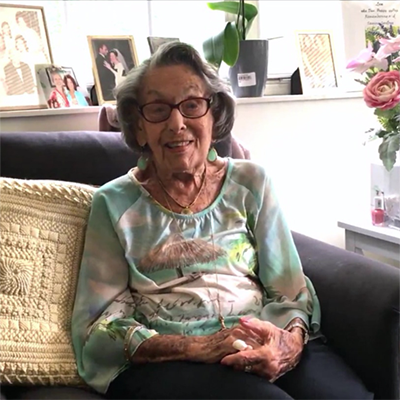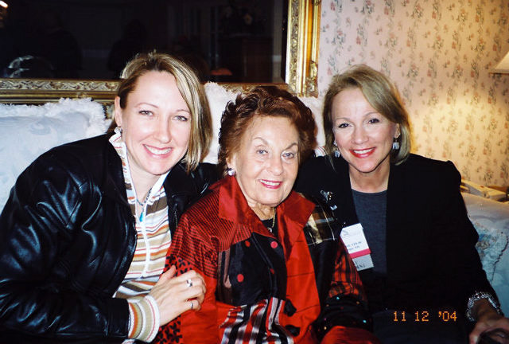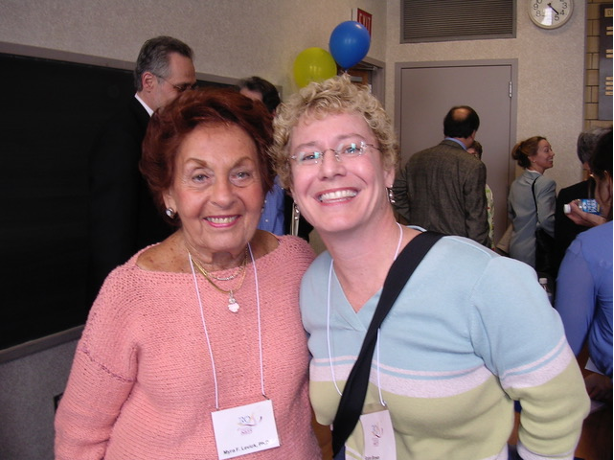October 19, 2020
The art therapy community mourns the loss of Myra Levick, PhD, ATR-BC, a legendary pioneer in the field of art therapy. Dr. Levick helped found the American Art Therapy Association (AATA) in 1969 and served as our first president. As she explained in the AATA’s first newsletter, “For the past twenty years artists have been involved in using their skills to aid in the diagnosis and treatment of psychiatric patients and in more recent years have not only begun to speak and write about their experiences, but have been recognized for their contributions. It is an established fact that an organization must be formed in order to attain professional recognition.”

Photo taken during a 2019 interview with Dr. Levick in celebration of AATA’s 50th Anniversary. (Click image to view the video). Photo courtesy of Bani Malhotra, ATR.
Like many women of her generation, Dr. Levick supported her husband through medical school and the start of his medical career while raising three daughters. “I would work while he was in medical school on condition that he would send me to art school, so 17 years later I went to Moore College of Art and Design,” she explained in a March 2019 news interview. Dr. Levick went on to earn a master’s degree in education from Temple University, and a Ph.D. in psychology from Bryn Mawr College.
Dr. Levick also co-founded one of the first graduate programs in art therapy in the world at the then-Hahnemann Medical College and Hospital (which became part of Drexel University in 2002). She had begun working there with patients after receiving her bachelor’s degree in painting. And almost a decade after the Hahnemann program was created, Dr. Levick became a tenured professor—and continued teaching at Hahnemann for 20 years while directing what became its Creative Arts in Therapy program and writing books and journal articles. She taught there until retiring in 1986 and moving to Florida, where she continued practicing art therapy and writing books.
She returned to the Philadelphia area in 2018, when her health began to decline, her daughter said, but continued teaching classes in “art and aging” at her assisted living facility. She passed away at age 96 on Sept. 16, 2020 of complications from a seizure.
Dr. Levick was a powerful advocate for education, the arts, and mental health—but also a passionate leader, visionary, mentor, and friend who touched the lives of so many of us. She will be missed every day. Read her obituary here.
AATA invites everyone to join us as we celebrate Myra’s life and the lives of other art therapists we lost this year during the virtual Memorial Service, to take place on Thursday, November 12th from 8:00 to 9:00 pm EST.
We sincerely thank each colleague and friend who submitted the below reminiscences and notes in memory of Myra Levick (listed alphabetically).

AATA past presidents (left to right): Donna Betts, PhD, ATR-BC; Myra Levick, PhD, ATR-BC; and Deborah Good, PhD, ATR-BC, ATCS, LPAT, LPCC. Photo taken in 2004, courtesy of Donna Betts.
Lanie Abrams, ATR, MFT
I was in the Art Therapy Program of 1968-1969. I have loved my career with art therapy through to present, still loving the work and eternally grateful. Myra, you were a little person standing on my right shoulder for my first 20 years of practice…critiquing.
Much gratitude for you and your career choice. Rest on Peace.
Robin Brown MCAT, MS, ATR-BC, LPC, ACS
I graduated from the Hahnemann Medical College in Art Therapy in 1981 and practiced Art Therapy every year since then. Myra’s program was brilliant with both classes and internships being inspirational. Myra was a trusted mentor for whom I had the utmost respect and admiration. It was an honor studying under her. I remember with awe in my second year at Hahnemann Medical College, she went to England to study under Anna Freud at the Hampstead Clinic. She was a legendary pioneer in the field of Art Therapy and will be greatly missed.

Myra and Robin at an event celebrating the Hahnemann Medical College’s 30 year anniversary of the MCAT program. Photo courtesy of Robin Brown.
Deborah Good, PhD, ATR-BC, ATCS, LPAT, LPCC
I will miss Myra Levick. I always will visualize her in two familiar settings at the annual conferences. The first one is with her charming husband Leonard who graciously flirted with everyone and was so obviously proud to be with his wife. They were the perfect example of a happy couple. Secondly, for some reason we always ran into each other at the registration desk. Myra made everyone feel like they were the only person in the room. Her face lit up when she greeted people and made everyone feel special, when it was just special to be around her. She encouraged involvement in the professional organization and expected it of those close to her.
Myra was a fierce supporter of art therapy causes. She always had an opinion and was not afraid to let people know what it was. We didn’t always agree, but she listened and respected that we might disagree. When Myra cornered me at a conference and said she needed to speak with me, it most definitely was something that she felt strongly about, what needed to change within the organization, or just to say that I had done a good job.
We had a connection that both of us were from southeastern Pennsylvania. But, it was after she moved to Florida that we would periodically talk on the phone. I remember texting with her when a hurricane hit her area. We texted through the evening, her telling me about the loud wind, how hurricane strong her building was, and how the windows rattled as the rain pelted on them. It’s an honor to say that Myra was my friend. I always will treasure our conversations.
Bobbi Stoll, MFT, CTS, CT, ATR-BC
“Remembering Myra Levick & Helen Landgarten”
Two women, residing on opposite sides of the country with successful professional husbands, became increasingly active after raising children to adulthood.
These two creative, progressive, active Jewish artists introduced creativity through art-making to ease distress, enhance healing and recovery and solve problems of living to supportive and encouraging staff doctors at major metropolitan training hospitals – Paul Fink, MD at Hahnemann Hospital in Philadelphia and Saul Brown, MD, family psychiatrist at Thalians Clinic in Cedar-Sinai Hospital in Los Angeles.
Is it any wonder these two women with so much in common formed a lifetime friendship from their first meeting at an early art therapy conference where the American Art Therapy Association was being finalized. Myra Levick had already started teaching art therapy at Hahnemann Hospital and, with Dr. Fink’s strong support, was a natural first president of the developing professional organization.
Myra Levick had a powerful influence on Helen Landgarten, an artist in Los Angeles, who was providing art therapy at Thalians Clinic in Cedar-Sinai Hospital and teaching social workers on staff about art therapy. With Myra’s encouragement, Helen eased into the Psychology department at Immaculate Heart College (IHC) with a single lecture and, at Myra’s urging, followed up with a one year art therapy certificate program.
Close friendships were formed between the Levicks and Landgartens when the women were accompanied to conferences by caring husbands, Leonard and Nate. They eventually traveled together and it’s easy to think much discussion and attention focused on art therapy graduate program development and what would be essential to adequately train professional art therapists.
It’s hard to know if Helen would have persisted in establishing a Master’s program in Los Angeles if Myra hadn’t been such a powerful advocate and model. Leonard also modeled strong wife support which Nate was eager to emulate. These two couples remained friends throughout their lives as the wives created parallel programs a full nation apart. Helen’s junior west coast program at Immaculate Heart College emulated Myra’s 3 year senior program in Philadelphia. To affiliate with a training hospital similar to Hahnemann, Helen sought approval for her classes at IHC to be included in family therapy training courses at Cedars-Sinai Hospital. Never competitors – just America’s prime model-mentor and her loyal follower, admirer and California friend.
Myra was the last of this foursome to die. She leaves behind many other followers, admirers and friends as well as an entire group of professional art therapists indebted to her pioneering work on multiple fronts. Her obituary reports multiple pioneering roles as teacher, editor, founder, author, consultant and pioneer.
Myra will be missed and eternally remembered.
These two women are fused in my memory. I admired and cared deeply for both. I was a student of Helen’s, west coast pioneer art therapist and Myra Levick shadow.
I exchanged emails and birthday greetings with Myra after her move to Florida and more frequently after Leonard’s death. We compared similarities and differences in our states’ temperatures, disasters, art therapy job growth and legislation and our retirement communities. I was always impressed and amazed at Myra’s active internet and email presence.
I personally envied Myra’s eyesight and insight!
Marcia F. Taylor, Ph.D, ATR-BC, LPAT
As a student at Moore College of Art in Philadelphia in the late 1960’s my classmates and I were introduced to a graduate program developing at Hahnemann Medical College and Hospital. Myra Levick, also a Moore alumna, was instrumental in creating the program of study. From those early years there was excitement about the new formalized course of study. For me personally I enrolled at Hahnemann in 1970 and received my Master’s in Art Therapy in 1972. The rest is history as Mrs. Levick, then Professor Levick, then Dr. Levick was a significant influence in both my professional career and personal life. One of the memorable experiences from my internship placements was every Monday in a therapeutic nursery school setting where Dr. Levick’s daughter Bonnie was the head teacher. Under her guidance and with Myra’s mentoring I taught a 15 minute art lesson to mainly 3 year olds! A true challenge keeping that little special population engaged!
I feel honored to have had Myra as a teacher and mentor. And her influence over the past 50 years is apparent to me as I reflect on my work with children, adults and incarcerated inmates serving life sentences. Her passionate belief in the therapeutic power of the arts, especially visual arts, encouraged me to pursue a doctorate in behavioral science. As luck would have it, I was able to select and invite Myra to join my dissertation committee. While the other members ‘went by the book’ of strict testing and research guidelines, Myra supported my use of drawings as a research tool. A member of the committee thought drawings were too loose a tool, but Myra concurred with me that the more rigid tools were too tight. And of course we won! The committee was overwhelmingly convinced of the power and significance of drawings in therapy and research.
There are many other important memories and connections with Dr. Levick. To name a few, I attended her LECATA workshop and incorporated that knowledge into my own classroom lectures. She encouraged me when I accepted a teaching position in an undergraduate art therapy program while at that time there existed a discouraging environment of not introducing art therapy to undergraduates. I returned to Moore College of Art to teach an orientation to art therapy survey course. She came to my classes as a guest speaker and author. She met my family and wrote letters and personal notes to keep in touch. I am truly blessed with Dr. Myra Levick’s impact on my life and career.
